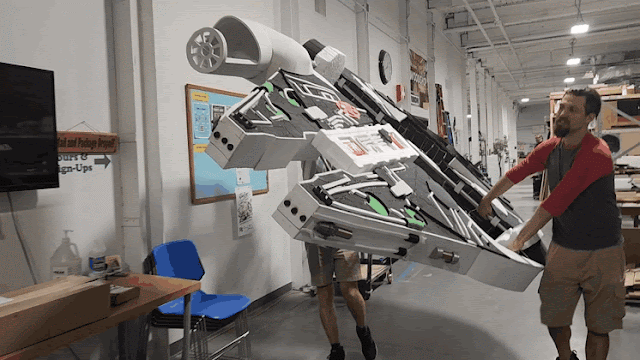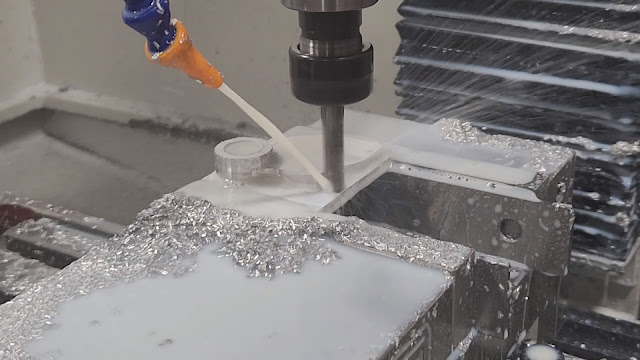What? You've never heard of the Aluminum Falcon? We did 0.2 parsecs of the Lowell Kinetic Sculpture Race! On zero sleep and with a patched together drive, we arrived at the starting line.
Being at the race is so exhilarating that I was feeling no pain. I didn't know how this was going to go, but I was already basking in the glory. To get the Falcon on and off the rental truck, we had to remove the canopy. We decided to walk the separate pieces to our starting location (at the back, because we were the last team to arrive).
Minions are the support crew (technical and emotional) that follow each sculpture throughout the race. Our minions and I rolled the base in while getting a few curious glances. Then, Andee and more minions "flew" the canopy through the crowd. They had to hold it up over their heads to clear the spectators, so she really did look airborne (spaceborne?).
 |
| Our amazing minions! Photo courtesy of Thomas Jokinen |
I heard one of the other builders exclaim, "Whoa! That goes on that," pointing to the canopy and then to the base. We drew a crowd as we plopped the skin back on. We basked.
 |
| Getting ready for the race. Photo courtesy of Thomas Jokinen |
We could only enjoy the moment for that one, single moment. The flurry of registration tasks began. Packets were handed out. The Falcon was inspected for safety. Castro played Star Wars music. Then it was immediately on to the opening ceremonies.
We took our kinetic pledge after all the speeches and entertainment then lined up across from the Aluminum Falcon. The LKSR has a Lemans style start where the race starts with a foot race, one of the many reasons why this race is so cool.
"Ready. Set. Go!"
Andee and I hot-footed across the street. I climbed in first and set up while Andee ducked under the canopy and settled into her seat. We were ready! I cranked my pedals. Pop!
We broke a chain immediately. My pedals started spinning quickly as the free end of the chain rolled off the sprockets. @#%*! This happened to us several times last year, so at least we knew what to do. It still took us five long minutes to reconnect the chain. It seemed like an eternity, long enough for the entire race to leave us behind.
"Maybe you should skip Bone Shaker Alley," our race marshall cautioned. The cobblestone-lined street was the first obstacle. With our hopes at being competitive well checked, we agreed and climbed back into the Falcon. The minions gave her a helpful push to get the wheels spinning. At that point, we just wanted to get on the road.
The Falcon rolled forward. I began to move my legs very slowly around the bottom crank. The drive was designed to be powered by two pilots, but we were only able to install one side. I lamented the loss of half our power in that moment. It felt like what I imagined flying a 747 on one engine would feel like. On top of that, the joystick began to slip so keeping her centered became an increasingly difficult problem.
 |
| We're off! Photo courtesy of Robby Zambito |
When we had agreed that we should skip the cobblestones, we did not take into account that we had to ride down an active street to do that. We led a very slow parade of cars down the street as the traffic light up ahead turned red. The pedals gave way again when we reached the light. I thought we had broken the pedal chain again, but it was worse than that. I looked down and saw the chain was still intact, but the freewheel was spinning freely around its shaft when I pedaled. I knew what that meant.
"It's over!" I yelled. "The freewheel broke loose from the driveshaft!"
The freewheel had been locked to the drive shaft with a small square piece of steel called a key. The key fits into slots cut into both the freewheel and shaft, locking the two together. We had sheared this key in half! We could no longer propel ourselves forward and since I hadn't brought spare keys, we could not fix it. Our race was over. If each mile equals 2 parsecs, then we went about .2 parsecs.
We pulled over to let all the motorized traffic go by and confirmed the freewheel failure. Castro played the end music from The Empire Strikes Back. So funny and so true. Hilariously appropriate. We turned the Falcon around. On the way back, the steering rod also broke loose. So that was going to happen had we been able to continue on.
 |
| Rolling the Falcon back to the start line. Photo courtesy of Thomas Jokinen |
As we licked our wounds back at the pit area, Castro said, "the chain strikes back." Indeed. Thwarted again by bicycle chain. It was hard not to be disappointed, but then I realized where we were our the story. This was just the second act.
The Aluminum Falcon Experience is just getting started. Stay tuned! 😊
 |
| Photo courtesy of Thomas Jokinen |






























































